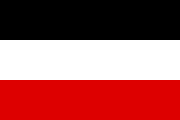
Back حزب الشعب الوطني الألماني Arabic حزب الشعب الوطنى الالمانى ARZ Нямецкая нацыянальная народная партыя Byelorussian DNVP BS Partit Nacional del Poble d'Alemanya Catalan Německá národně lidová strana Czech Deutschnationale Volkspartei Danish Deutschnationale Volkspartei German Γερμανικό Εθνικό Λαϊκό Κόμμα Greek Deutschnationale Volkspartei Esperanto
German National People's Party Deutschnationale Volkspartei | |
|---|---|
 | |
| Other name | Deutsche Nationale Front (1933) |
| Founded | 24 November 1918 |
| Dissolved | 27 June 1933[1] |
| Merger of | DkP, FKP, DVLP, DvP, CSP, NLP[n 1] |
| Succeeded by | None[n 2] |
| Youth wing | Bismarckjugend[8][9] |
| Women's wing | Queen Louise League (unofficial)[10] |
| Paramilitary wing | Kampfstaffeln (from 1931)[11] |
| Media group | Hugenberg Group[12][13][14] |
| Membership | 950,000 (mid-1923 est.) |
| Ideology | |
| Political position | Right-wing to far-right[n 3] |
| Religion | Protestantism[17] |
| Political alliance |
|
| Electoral alliance | Kampffront Schwarz-Weiß-Rot (1933) |
| Colours |
|
| Party flag | |
 | |
| This article is part of a series on |
| Conservatism in Germany |
|---|
 |
The German National People's Party (German: Deutschnationale Volkspartei, DNVP) was a national-conservative and monarchist political party in Germany during the Weimar Republic.[20][21] Before the rise of the Nazi Party, it was the major nationalist party in Weimar Germany. It was an alliance of conservative, nationalist, monarchist, völkisch, and antisemitic elements supported by the Pan-German League.[22] Ideologically, the party was described as subscribing to authoritarian conservatism,[23] German nationalism,[24] monarchism,[25][26] and from 1931 onwards also to corporatism in economic policy.[27] It held anti-communist, anti-Catholic,[28][29][30] and antisemitic views.[31][32] On the left–right political spectrum, it belonged on the right-wing,[33][34] and is classified as far-right in its early years and then again from the late 1920s when it moved back rightward.[15][16]
It was formed in late 1918 after Germany's defeat in World War I and the German Revolution of 1918–1919 that toppled the German Empire and the monarchy. It combined the bulk of the German Conservative Party, Free Conservative Party, and German Fatherland Party, with right-wing elements of the National Liberal Party. The party strongly rejected the republican Weimar Constitution of 1919 and the Treaty of Versailles, which it viewed as a national disgrace, signed by traitors. The party instead aimed at a restoration of monarchy, a repeal of the dictated peace treaty and reacquisition of all lost territories and colonies.
During the mid-1920s, the DNVP moderated its profile, accepting republican institutions in practice while still calling for a return to monarchy in its manifesto, and participating in centre-right coalition governments on federal and state levels. It broadened its voting base—winning as much as 20.5% in the December 1924 German federal election—and supported the election of Paul von Hindenburg as President of Germany (Reichspräsident) in 1925. Under the leadership of the populist media entrepreneur Alfred Hugenberg from 1928, the party moved to the far-right and reclaimed its reactionary nationalist and anti-republican rhetoric and changed its strategy to mass mobilisation, plebiscites, and support of authoritarian rule by the president instead of work by parliamentary means. At the same time, it lost many votes to Adolf Hitler's rising Nazi Party. Several prominent Nazis began their careers in the DNVP.
After 1929, the DNVP co-operated with the Nazis, joining forces in the Harzburg Front of 1931, forming coalition governments in some states and finally supporting Hitler's appointment as Chancellor of Germany (Reichskanzler) in January 1933. Initially, the DNVP had a number of ministers in Hitler's government, but the party quickly lost influence and eventually dissolved itself in June 1933, giving way to the Nazis' single-party dictatorship with the majority of its former members joining the Nazi Party. The Nazis allowed the remaining former DNVP members in the Reichstag, the civil service, and the police to continue with their jobs and left the rest of the party membership generally in peace. During the Second World War, several prominent former DNVP members, such as Carl Friedrich Goerdeler, were involved in the German resistance to Nazism and took part in the 20 July plot to assassinate Hitler in 1944.
- ^ "Nazis Outlaw Nationalists As Rival Party". Milwaukee Sentinel. 28 June 1933. p. 2.
- ^ Eatwell, Roger (2003). Fascism: A History. London: Pimlico. p. 277. ISBN 9781844130900.
- ^ Dudek, Peter; Jaschke, Hans-Gerd (1984). Entstehung und Entwicklung des Rechtsextremismus in der Bundesrepublik (in German). Vol. 1. Westdeutscher Verlag. pp. 181–201.
- ^ D. Childs, 'The Far-Right in Germany since 1945', L. Cheles, R. Ferguson & M. Vaughan, Neo-Fascism in Europe, Harlow: Longman, 1992, p. 70.
- ^ Stöss, Richard (1989). Die extreme Rechte in der Bundesrepublik: Entwicklung – Ursachen – Gegenmaßnahmen. Westdeutscher Verlag. p. 126
- ^ Luciano Cheles, Ronnie Ferguson & Michalina Vaughan, Neo-Fascism in Europe, Longman, 1991, p. 71
- ^ Horst W. Schmollinger, Richard Stöss, Die Parteien und die Presse der Parteien und Gewerkschaften in der Bundesrepublik Deutschland 1945–1974, Westdeutscher Verlag 1975, S. 187
- ^ Gerwarth, Robert (2005). The Bismarck Myth: Weimar Germany and the Legacy of the Iron Chancellor. Oxford Historical Monographs. Oxford: Clarendon Press. pp. 106–107. ISBN 978-0-19-928184-8.
- ^ Jones, Larry Eugene; Retallack, James N. (1992). Elections, Mass Politics, and Social Change in Modern Germany: New Perspectives. Washington, D.C.: German Historical Institute. p. 354. ISBN 9780521429122.
- ^ Fisher, Conan (1996). The Rise of National Socialism and the Working Classes in Weimar. Providence/Oxford: Berghahn Books. ISBN 9781571819154.
- ^ Beck (2009) p. 26.
- ^ Foster, Frances (September 1996). The press of the Weimar Republic and its representation in German literature (PDF) (PhD thesis). University of Bristol. pp. 9–10.
- ^ Wistrich, Robert (1984). Who's Who in Nazi Germany. p. 157.
- ^ Holzbach, Heidrun (1981). Das "System Hugenberg". Die Organisation bürgerlicher Sammlungspolitik vor dem Aufstieg der NSDAP [The "Hugenberg System": The organ of bourgeois collection policy before the rise of the NSDAP]. Stuttgart: Deutsche Verlags-Anstalt. ISBN 3-421-01986-X. (Additional dissertation, University of Munich 1979.)
- ^ a b Caldwell, Peter C. (1997). Popular Sovereignty and the Crisis of German Constitutional Law: The Theory & Practice of Weimar Constitutionalism. Duke University Press. p. 74.
- ^ a b Caldwell, Peter C. (2008). "The Citizen and the Republic in Germany, 1918–1935". Citizenship and National Identity in Twentieth-Century Germany. Stanford University Press. p. 48.
- ^ Beck (2009), p.43
- ^ Pfleiderer, Doris (2007). "Volksbegehren und Volksentscheid gegen den Youngplan, in: Archivnachrichten 35 / 2007" [Initiative and Referendum against the Young Plan, in: Archived News 35 / 2007] (PDF). Landesarchiv Baden-Württemberg (in German). p. 43. Retrieved 26 November 2022.
- ^ Reagin, Nancy R. (2007). Sweeping the German Nation: Domesticity and National Identity in Germany, 1870–1945. Cambridge University Press. p. 106.
- ^ Kitchen, Martin (2006). Europe Between the Wars: A Political History (2nd ed.). Pearson Education. p. 249.
- ^ Barth, Boris (2006). Genozid: Völkermord im 20. Jahrhundert: Geschichte, Theorien, Kontroversen (in German). C. H. Beck. p. 176.
- ^ Nicholls, David (2000). Adolf Hitler: a biographical companion. Oxford: ABC-CLIO. p. 178.
The main nationalist party the German National People's Party DNVP was divided between reactionary conservative monarchists, who wished to turn the clock back to the pre-1918 Kaiserreich, and more radical volkisch and anti-semitic elements. It also inherited the support of old Pan-German League, whose nationalism rested on belief in the inherent superiority of the German people.
- ^ Seymour M. Lipset, "Social Stratification and 'Right-Wing Extremism'" British Journal of Sociology 10#4 (1959), pp. 346–382 on-line Archived April 22, 2022, at the Wayback Machine
- ^ Kaes, Anton; Jay, Martin; Dimendberg, Edward, eds. (1994). "German National People's Party Program". The Weimar Republic Sourcebook. Los Angeles: University of California Press. pp. 348–350.
- ^ "German National People's Party Program" pages 348–352 from The Weimar Republic Sourcebook edited by Anton Kaes, Martin Jay and Edward Dimendberg, Los Angeles: University of California Press, 1994 page 349.
- ^ Ringer, Fritz K. (1990). The Decline of the German Mandarins: The German Academic Community, 1890–1933. University Press of New England. p. 201.
- ^ Evans, Richard J. (2004). The Coming of the Third Reich. Penguin Books. p. 95. ISBN 978-0143034698.
- ^ Preisinger, Arthur A. (1991). The church struggle in Nazi Germany, 1933–34: Resistance, opposition, or compromise. Lubbock, Texas: Texas Tech University Press. p. 46. hdl:2346/12591.
- ^ Kaiser, Jochen-Christoph; Greschat, Martin (1988). Der Holocaust und die Protestanten: Analysen einer Verstrickung (in German). Frankfurt am Main: Athenäum Verlag. pp. 48–49. ISBN 9783610085032.
- ^ Hertzman, Lewis (1963). DNVP: Right-wing opposition in the Weimar Republic, 1918–1924. Lincoln: University of Nebraska Press. p. 45. ISBN 9780835738026.
- ^ Weitz, Eric D. (2007). Weimar Germany: Promise and Tragedy. Princeton, New Jersey: Princeton University Press. pp. 95–96.
- ^ Evans, Richard J. (2004). The Coming of the Third Reich. Penguin Books. p. 95. ISBN 978-0143034698.
- ^ Jones, Larry Eugene; Retallack, James (1992). Introduction. Cambridge University Press. p. 11.
{{cite book}}:|work=ignored (help) - ^ Stibbe, Matthew (2010). Germany, 1914–1933: Politics, Society and Culture. Pearson Education. p. 212.
Cite error: There are <ref group=n> tags on this page, but the references will not show without a {{reflist|group=n}} template (see the help page).